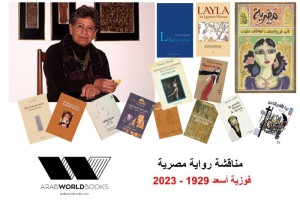Reviewed by Injy El-Kashef
Ahram Weekly
Most of the 12 stories contained in The Hill of Gypsies leave the pages of the book damp with tears. Not the reader's tears, but everything else's: people, animals, rivers; everything cries. Tears, of course, have their charm, especially when it is a camel that "in a broken voice...wept and wailed". And in "The Camel, Abdul Mawla, the Camel!" the camel, in fact, weeps twice, when Abdul Mawla finally gathers the courage to look it in the eye.
Abdul Mawla, the boy protagonist of many of the stories, is always afraid of something, always "filling the world with [his] wailing", always peeing on himself. That is not to say that many of the more poetic passages were not spoken or thought by him.
Abdul Mawla, "that boy who was baffled by the alphabet of things", thinks quite a lot, and his thinking is exceedingly sensitive. He hears the "sailors singing and would know that they were unhappy", he sees "darkness like that of the wells dug at the ends of the world", he says to his grandfather that he "would give him the sun, and he had said to [him] from a mouth devoid of teeth that he must be watchful... against becoming drowsy near the well", and he loves the blind Sheikha Aneesa who had learnt the entire Qur'an by heart when she was seven and "made her final journey on a Friday". He is also capable of extreme cruelty as when he locks up the wolf cub in his obstinate attempt to tame it. "Once it's hungry it'll eat whether it likes it or not"; well, it likes it so little that it dies in three days.
The Hill of Gypsies is devoid of humour, except maybe for the tale of "The Tracker" who, at an auction, bids LE20,000 for a jewel-encrusted lamp when in fact he has no more than a few piastres ("Am I swimming in the times of pearls?"). The stories are based around simple plots, each intended to emphasise a particular emotion. Many explore the protagonist's strong, irrational fear of someone or something; others, like "Absence", "The Gazelle Hunter" and "The Blind Sheikh", leave the reader smiling. In many of these stories, however, there is a vague sense of insanity floating in the air, which might be due to the fact that the protagonist's feelings are always too intense to secure rationality.
Author Said El-Kafrawi probably did not intend it, but some readers may find that his descriptions of the gypsy community, as described in the title story -- my least favourite -- verge on the ludicrous. Not only are the gypsies seriously exoticised, but they are depicted as members of a third rate ambulating circus.
The gypsies wear braided locks, silver earrings ("from which dangled small bells") in their left ears and rings with bezels in the form of scarabs. Their hawk eyes are sunk beneath eyebrows that join, their teeth are capped with golden crowns and a snake (that "bared its fangs and stared about with unblinking eyes") curls around the arm of a man on whose shoulder sits a monkey ("its face expressing the wisdom found in old men"). The gypsies are attractive, charming, knowledgeable, powerful and threatening -- how strange, aren't they always? -- they are the ones that call children "by names other than their own".
Identity -- always a serious matter. There are several not-so-subtle bogey figures in this collection of short stories. Apart from the gypsies, who go as far as tearing the boy's heart out of his chest and replacing it after a cleansing ritual during Ramadan, there is the man from Java with "necklaces in a thousand colors and shapes" and who knows where the fascinating bird in "The Boy on the Bridge" comes from; there is the daughter of "The Man With the Traps", "the girl with the nocturnal locks, a magic voice, and with the sea looking out from her eyes, the girl who could speak several languages") and whose disappearance causes her crazy father to haunt the protagonist in the most nightmarish fashion; and there is the disgraced family involved in "A Matter of Honour", where the pretty girl who loses hers has "a complexion as white as cream and eyes the color of clover, with her two blond plaits under a blue shawl".
If the odd one out is made so odd, the assertion of identity is more elegant. There are the trees: lemon, date palm, eucalyptus, mulberry, guava, orange, olive, cypress, willow, casuarina, sycamore, mastic, sant, jujube, pomegranate and lotus-fruit. There are the animals which not only serve metaphorically ("restive as a young donkey"), but play an active role in many of the stories. And there are the elements: "the river is a screen against sin, its waters the tears of the repentant". Everything is alive, just as everything weeps. Magic realism? Sure. Somewhat contrived? Absolutely: "The heart of the bridge beats and prepares to meet the tread of human beings and the hooves of animals".
The author's juggling with the levels of the narrator's consciousness, on the other hand, is admirable. Dreams slide into reality, the self becomes the other, the young boy's voice acquires omniscient powers, and the whole world seems to be listening. The translator surely found much to wrestle with in these 12 stories, but the result meets the reader's expectations.
There is nothing vulgar about the poetic passages, there is nothing embarrassing about the emotional intensity of the tales, and something rather benign results from reading this book. The visual descriptions, the rural settings, the boy's wailing, or possibly another concealed factor, have a rather soothing effect on the reader, like a cup of warm mint.
Weeping and wailing
By: Editor - on: Friday 1 January 2010 - Genre: Book Reviews
Upcoming Events

Joseph Conrad's Heart of Darkness Discussion
April 27, 2024
Join us for a special discussion of Joseph Conrad&...

A writer, a vision, a journey: a conversation with Francis Boyle
February 24, 2024
This event took place on 24 February 2024 Yo...

Discussion of Fawzia Assaad’s An Egyptian Woman
November 25, 2023
In celebration of the life and outstanding achieve...

Toni Morrison's The Bluest Eye, A Presentation and Discussion
October 28, 2023
This presentation and discussion of Toni Morrison&...
